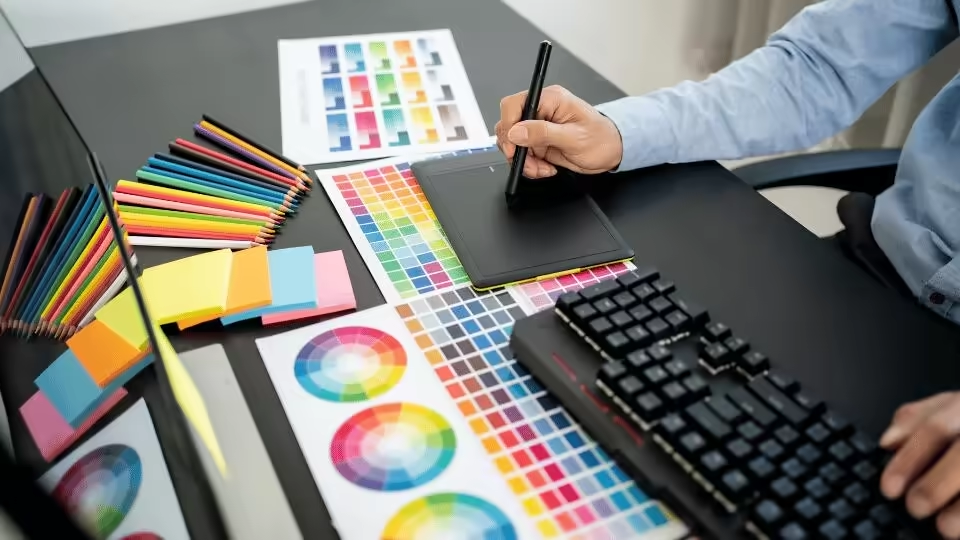The graphic Designer job description outlines the primary responsibilities of a professional tasked with creating images and designs to convey messages, ideas, and concepts through visuals for different needs, such as marketing, websites, and social media. Their daily tasks include designing layouts, choosing colors and fonts, and editing images.
Employers seek individuals with a strong blend of creativity, technical proficiency, and effective communication skills. Graphic designers must deeply understand design principles, including layout, composition, color theory, and typography. They should be able to translate abstract concepts into visually compelling designs that effectively communicate messages and ideas to target audiences.
They often collaborate with colleagues, like marketing teams or clients, to understand their needs and ensure the designs match the message. Graphic Designers work in various industries, like advertising, media, technology, and fashion, bringing their artistic touch to different fields.
Graphic Designer Job Description: Overall Purpose
Produces visual content effectively, communicating messages, concepts, and ideas to target audiences. Their design work is pivotal in the visual identity of brands and organizations.
Graphic Designer Job Description: Primary duties
- Creates and designs visual materials, including logos, banners, brochures, posters, infographics, and other marketing collateral, using design software and tools to create high-quality visual content.
- Works closely with clients or stakeholders to understand design requirements and objectives through collaborative interactions.
- Develops design concepts, graphics, and layouts based on the project's goals and objectives.
- Enhances the visual appeal of materials by selecting appropriate colors, images, and typography.
- Ensures effective communication through editing and modifying existing designs to meet specific needs or preferences.
- Ensures cohesive and impactful designs by collaborating with other team members, such as copywriters and marketers.
- Generates contemporary and pertinent visual material by keeping abreast of design trends and developments in the industry.
- Maintains consistency and brand integrity by adapting designs for various platforms and formats.
Related: Web Designer Job Description
Graphic Designer Job Description: Educational Qualifications
- A degree in Graphic Design, Visual Arts or a related field is typically required to provide the foundational knowledge and skills for the role. Additional certifications or specialized courses in design software and techniques can enhance a Graphic Designer's qualifications.
Graphic Designer Job Description: Experience Required
- Demonstrated experience in graphic design, either through internships, freelance work, or previous employment.
- Proficiency in design software such as Adobe Creative Suite (Photoshop, Canva, Illustrator, InDesign) and other relevant tools.
- Experience creating visual content for both print and digital platforms.
- Strong portfolio showcasing a variety of design projects and styles.
Graphic Designer Job Description: Knowledge, Skills, Abilities, and Other Characteristics (KSAO)
Knowledge
- Knowledge of design principles, including layout, composition, color theory, and typography.
- Knowledge of visual communication principles and the skill to transform concepts into engaging designs.
- Knowledge of industry-specific trends and best practices in graphic design, ensuring up-to-date and effective creations.
Skills
- Creative thinking and the ability to generate original design concepts.
- Strong proficiency in design software and tools.
- Attention to detail and a keen eye for aesthetics.
- Excellent communication skills to understand client requirements and present design ideas effectively.
Abilities
- Ability to manage multiple projects and meet deadlines in a fast-paced environment.
- Ability to effectively solve design problems and create visually attractive solutions.
- Ability to work independently and collaboratively, taking feedback and incorporating design changes.
Conclusion
A Graphic Designer plays a pivotal role in shaping the visual representation of brands and organizations. Their creativity, technical skills, and eye for aesthetics contribute to effective communication and engagement with target audiences. By combining design principles with modern tools and software, Graphic Designers contribute to businesses' visual identity and success across various industries.
Frequently asked questions
Is a degree in Graphic Design necessary to become a Graphic Designer?
While a degree in Graphic Design or a related field provides a strong foundation, individuals can also acquire design skills through specialized courses and practical experience.
What types of projects does a Graphic Designer work on?
Graphic Designers work on a wide range of projects, including branding, marketing materials, web design, social media graphics, packaging, and more.
What skills are essential for a Graphic Designer?
Important skills include proficiency in design software, creativity, attention to detail, strong communication, and the ability to adapt designs for different platforms.
Can a Graphic Designer work remotely or as a freelancer?
Many Graphic Designers work remotely or freelance, collaborating with clients and teams digitally. This flexibility allows them to take on diverse projects from various locations.
How important is keeping up with design trends?
Staying updated with design trends is crucial for Graphic Designers to create relevant and impactful designs that resonate with target audiences and align with current visual aesthetics.

